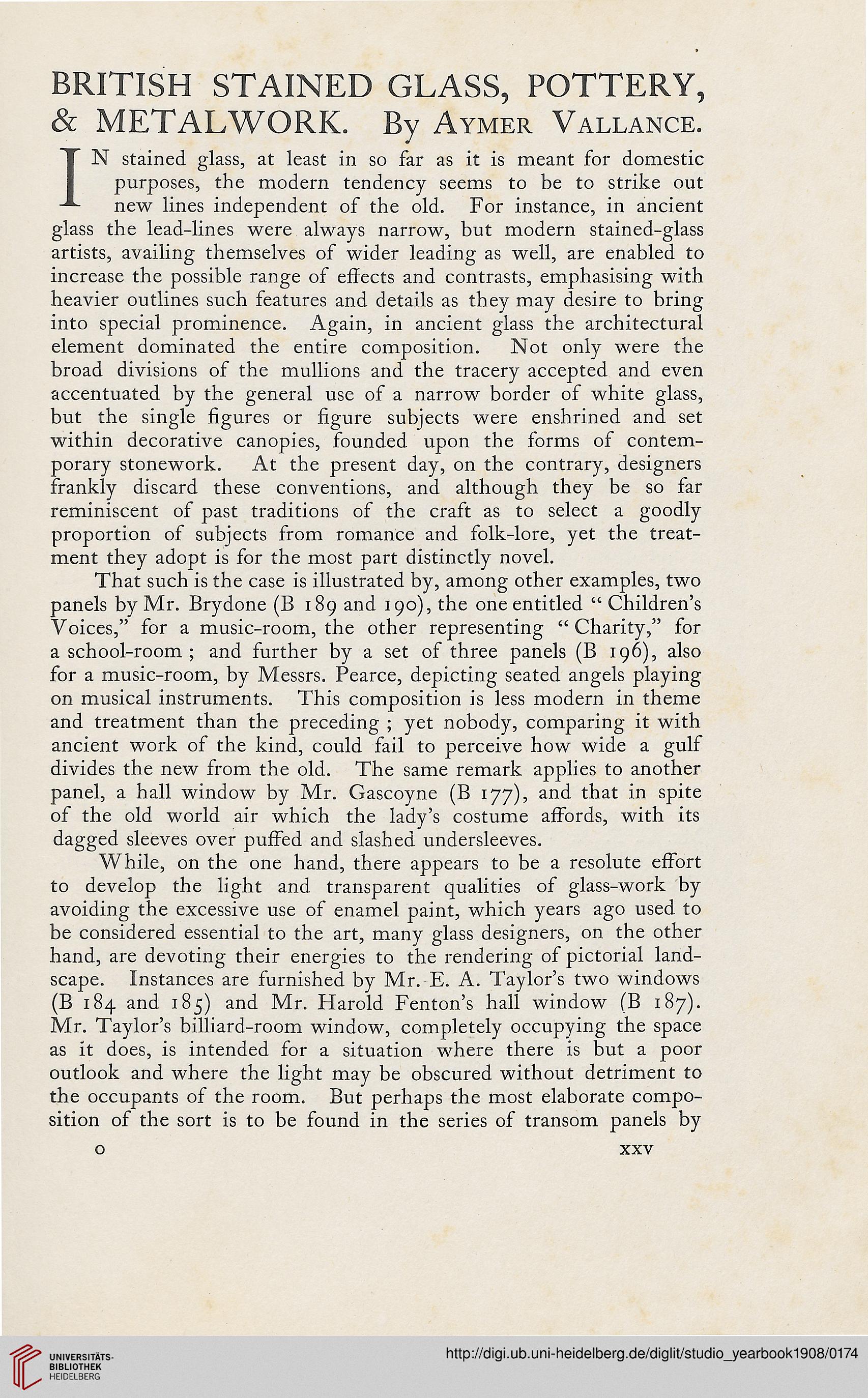BRITISH STAINED GLASS, POTTERY,
& METALWORK. By Aymer Vallance.
IN stained glass, at least in so far as it is meant for domestic
purposes, the modern tendency seems to be to strike out
new lines independent of the old. For instance, in ancient
glass the lead-lines were always narrow, but modern stained-glass
artists, availing themselves of wider leading as well, are enabled to
increase the possible range of effects and contrasts, emphasising with
heavier outlines such features and details as they may desire to bring
into special prominence. Again, in ancient glass the architectural
element dominated the entire composition. Not only were the
broad divisions of the mullions and the tracery accepted and even
accentuated by the general use of a narrow border of white glass,
but the single figures or figure subjects were enshrined and set
within decorative canopies, founded upon the forms of contem-
porary stonework. At the present day, on the contrary, designers
frankly discard these conventions, and although they be so far
reminiscent of past traditions of the craft as to select a goodly
proportion of subjects from romance and folk-lore, yet the treat-
ment they adopt is for the most part distinctly novel.
That such is the case is illustrated by, among other examples, two
panels by Mr. Brydone (B 189 and 190), the one entitled " Children's
Voices," for a music-room, the other representing " Charity," for
a school-room ; and further by a set of three panels (B 196), also
for a music-room, by Messrs. Pearce, depicting seated angels playing
on musical instruments. This composition is less modern in theme
and treatment than the preceding ; yet nobody, comparing it with
ancient work of the kind, could fail to perceive how wide a gulf
divides the new from the old. The same remark applies to another
panel, a hall window by Mr. Gascoyne (B 177), and that in spite
of the old world air which the lady's costume affords, with its
dagged sleeves over puffed and slashed undersleeves.
While, on the one hand, there appears to be a resolute effort
to develop the light and transparent qualities of glass-work by
avoiding the excessive use of enamel paint, which years ago used to
be considered essential to the art, many glass designers, on the other
hand, are devoting their energies to the rendering of pictorial land-
scape. Instances are furnished by Mr. E. A. Taylor's two windows
(B 184 and 185) and Mr. Harold Fenton's hall window (B 187).
Mr. Taylor's billiard-room window, completely occupying the space
as it does, is intended for a situation where there is but a poor
outlook and where the light may be obscured without detriment to
the occupants of the room. But perhaps the most elaborate compo-
sition of the sort is to be found in the series of transom panels by
o xxv
& METALWORK. By Aymer Vallance.
IN stained glass, at least in so far as it is meant for domestic
purposes, the modern tendency seems to be to strike out
new lines independent of the old. For instance, in ancient
glass the lead-lines were always narrow, but modern stained-glass
artists, availing themselves of wider leading as well, are enabled to
increase the possible range of effects and contrasts, emphasising with
heavier outlines such features and details as they may desire to bring
into special prominence. Again, in ancient glass the architectural
element dominated the entire composition. Not only were the
broad divisions of the mullions and the tracery accepted and even
accentuated by the general use of a narrow border of white glass,
but the single figures or figure subjects were enshrined and set
within decorative canopies, founded upon the forms of contem-
porary stonework. At the present day, on the contrary, designers
frankly discard these conventions, and although they be so far
reminiscent of past traditions of the craft as to select a goodly
proportion of subjects from romance and folk-lore, yet the treat-
ment they adopt is for the most part distinctly novel.
That such is the case is illustrated by, among other examples, two
panels by Mr. Brydone (B 189 and 190), the one entitled " Children's
Voices," for a music-room, the other representing " Charity," for
a school-room ; and further by a set of three panels (B 196), also
for a music-room, by Messrs. Pearce, depicting seated angels playing
on musical instruments. This composition is less modern in theme
and treatment than the preceding ; yet nobody, comparing it with
ancient work of the kind, could fail to perceive how wide a gulf
divides the new from the old. The same remark applies to another
panel, a hall window by Mr. Gascoyne (B 177), and that in spite
of the old world air which the lady's costume affords, with its
dagged sleeves over puffed and slashed undersleeves.
While, on the one hand, there appears to be a resolute effort
to develop the light and transparent qualities of glass-work by
avoiding the excessive use of enamel paint, which years ago used to
be considered essential to the art, many glass designers, on the other
hand, are devoting their energies to the rendering of pictorial land-
scape. Instances are furnished by Mr. E. A. Taylor's two windows
(B 184 and 185) and Mr. Harold Fenton's hall window (B 187).
Mr. Taylor's billiard-room window, completely occupying the space
as it does, is intended for a situation where there is but a poor
outlook and where the light may be obscured without detriment to
the occupants of the room. But perhaps the most elaborate compo-
sition of the sort is to be found in the series of transom panels by
o xxv





